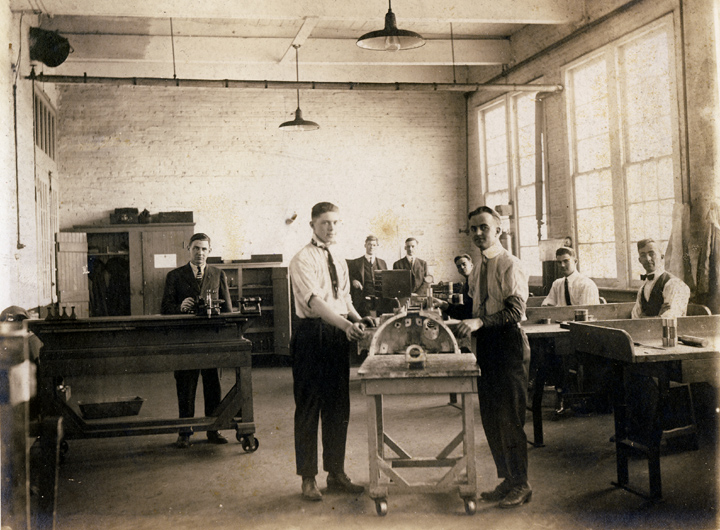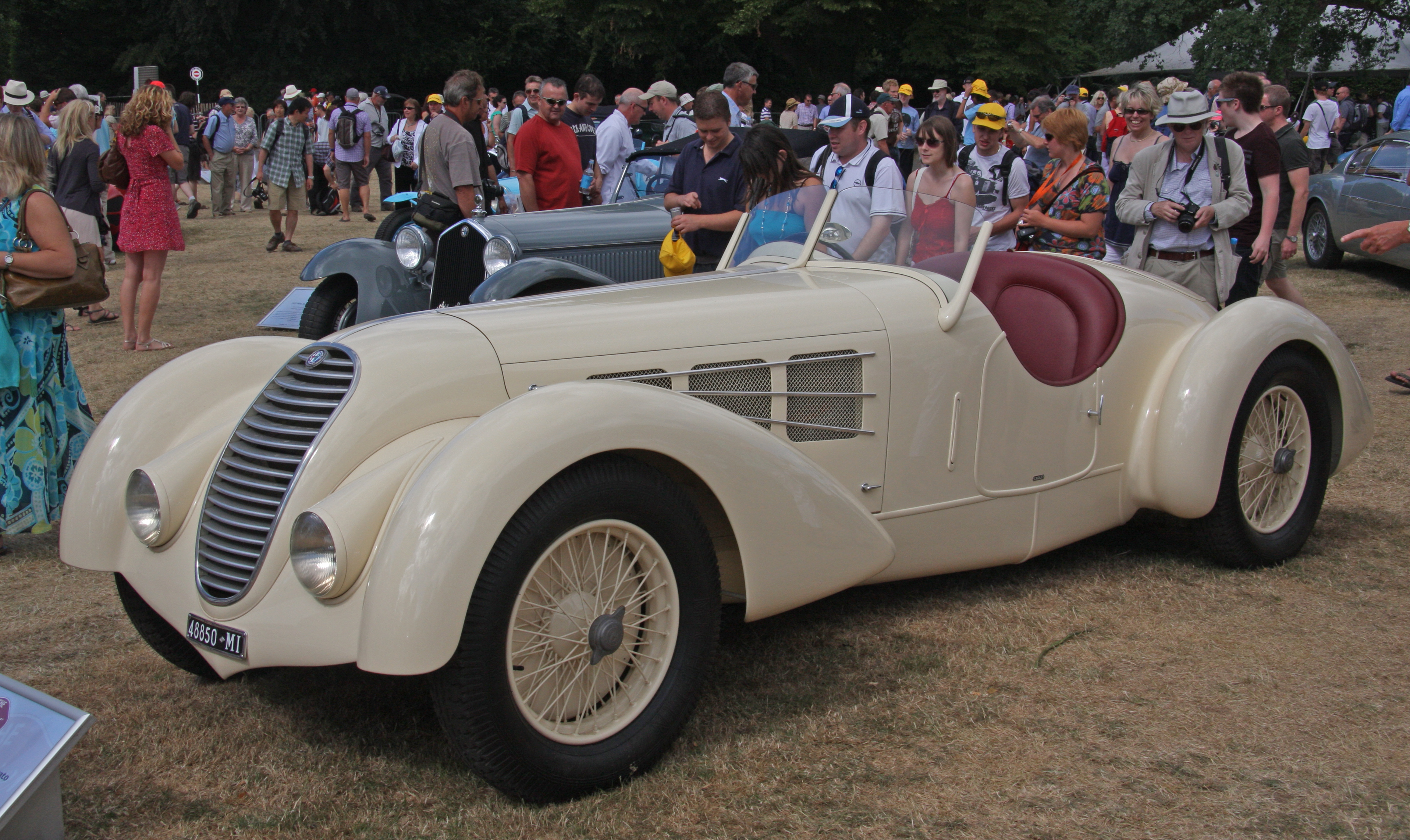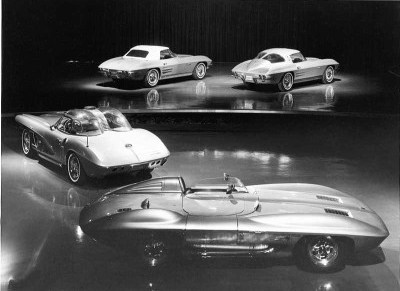|
Simeone Foundation Automotive Museum
The Simeone Foundation Automotive Museum is an automotive museum located at 6825 Norwitch Drive in Philadelphia, Pennsylvania. The museum's collection consists of approximately 75 racing sports cars and has been assembled over more than 50 years by Frederick A. Simeone, a retired neurosurgeon and native of Philadelphia. Frederick Simeone has been ranked the #1 car collector by the Classic Car Trust Registry. History Frederick Simeone's father was a general practitioner who ran his medical practice out of a rowhouse in the Kensington section of Philadelphia. When his father died in 1972, Simeone was left with $8,000 and 4 cars which were stored in a garage on Clearfield Street. He grew this collection over the next four decades, and in 2008 he donated the entire collection of cars to the museum's foundation, which now owns the titles to the cars. From 1982 until the Museum's opening in June 2008, the cars were stored in a garage near 8th and Lombard Streets in Philadelphia. Dr. Sime ... [...More Info...] [...Related Items...] OR: [Wikipedia] [Google] [Baidu] |
Philadelphia
Philadelphia, often called Philly, is the largest city in the Commonwealth of Pennsylvania, the sixth-largest city in the U.S., the second-largest city in both the Northeast megalopolis and Mid-Atlantic regions after New York City. Since 1854, the city has been coextensive with Philadelphia County, the most populous county in Pennsylvania and the urban core of the Delaware Valley, the nation's seventh-largest and one of world's largest metropolitan regions, with 6.245 million residents . The city's population at the 2020 census was 1,603,797, and over 56 million people live within of Philadelphia. Philadelphia was founded in 1682 by William Penn, an English Quaker. The city served as capital of the Pennsylvania Colony during the British colonial era and went on to play a historic and vital role as the central meeting place for the nation's founding fathers whose plans and actions in Philadelphia ultimately inspired the American Revolution and the nation's inde ... [...More Info...] [...Related Items...] OR: [Wikipedia] [Google] [Baidu] |
Mercer (automobile)
Mercer was an American automobile manufacturer from 1909 until 1925. It was notable for its high-performance cars, especially the Type 35 Raceabout. History The Mercer Automobile Company was formed in May 1909 in Trenton, Mercer County, New Jersey. It evolved from the Walter Automobile Company, which had built the Walter and Roebling-Planche automobiles. Washington A. Roebling II arranged with William Walter, to take over his automobile company and use a vacant brewery in Hamilton, New Jersey, owned by the Kuser family. Ferdinand Roebling, son of John A. Roebling, was the president, and his nephew Washington became general manager. The secretary-treasurer was John L. Kuser. The first Mercer cars arrived in 1910. A.R. Kingston, E.T. George and C.G. Roebling were credited with the design. The Mercer was available as a speedster, toy tonneau or touring car and were powered by four-cylinder L-head Beaver engines. The T-head Raceabout was announced late in 1910 for the 19 ... [...More Info...] [...Related Items...] OR: [Wikipedia] [Google] [Baidu] |
BMW 328
The BMW 328 was a sports car offered by BMW from 1936 to 1940, with the body design credited to Peter Szymanowski, who became BMW chief of design after World War II (although technically the car was designed by Fritz Fiedler). Specifications Awards In 1999 the BMW 328 was named one of 25 finalists for Car of the Century by a worldwide panel of automotive journalists. Motorsports The 328 was introduced at the Eifelrennen race at the Nürburgring in 1936, where Ernst Henne drove it to win the 2.0-litre class.Noakes, p. 31 The 328 had more than 100 class wins in 1937, including the RAC Tourist Trophy, the Österreichische Alpenfahrt, and the La Turbie hillclimb. Norbye, pp. 66–67 In 1938, the 328 won its class at the RAC Tourist Trophy,Noakes, p. 35 the Alpine Rally, and the Mille Miglia. The 328 won the RAC Rally in 1939 and came in fifth overall and first in class in the 1939 24 Hours of Le Mans. Norbye, p. 67 Frank Pratt won the 1948 Australian Grand Prix driving a ... [...More Info...] [...Related Items...] OR: [Wikipedia] [Google] [Baidu] |
Vauxhall 30-98
The Vauxhall 30–98 is a car manufactured by Vauxhall at Luton, Bedfordshire from 1913 to 1927. In its day, its best-known configuration was the Vauxhall Velox (''velox'', ''veloc''- being Latin for "swift"/"fleet" and the source of English ''velocity'') standard 4-seater with open tourer body. Vauxhall's own description was ''the 30–98 hp Vauxhall-Velox sporting car''. The 30–98 is also known to enthusiasts by Vauxhall's chassis code E. In 1995 it was authoritatively described as one of Britain's best-known sports cars and in the mid-20th century reported by '' Automobile Quarterly'' to be affectionately known as the last of the Edwardians and decreed as the first and perhaps the best British sports car. Origin The first 30–98 was constructed at the behest of car dealer and motor sport competitor Joseph Higginson, inventor of the Autovac fuel lifter. He won the Shelsley Walsh hill-climb motoring competition on 7 June 1913 in his new Vauxhall, setting a hill record in ... [...More Info...] [...Related Items...] OR: [Wikipedia] [Google] [Baidu] |
Bentley 4½ Litre
The Bentley 4½ Litre is a British car based on a rolling chassis built by Bentley Motors. Walter Owen Bentley replaced the Bentley 3 Litre with a more powerful car by increasing its engine displacement to . A racing variant was known as the Blower Bentley. Bentley buyers used their cars for personal transport and arranged for their new chassis to be fitted with various body styles, mostly saloons or tourers. However, the publicity brought by their competition programme was invaluable for marketing Bentley's cars. At the time, noted car manufacturers such as Bugatti and Lorraine-Dietrich focused on designing cars to compete in the 24 Hours of Le Mans, a popular automotive endurance course established only a few years earlier. A victory in this competition quickly elevated any car maker's reputation. A total of 720 4½ Litre cars were produced between 1927 and 1931, including 55 cars with a supercharged engine popularly known as the Blower Bentley. A 4½ Litre Bentley won the ... [...More Info...] [...Related Items...] OR: [Wikipedia] [Google] [Baidu] |
Alfa Romeo RL
The Alfa Romeo RL was produced between 1922–1927. It was Alfa's first sport model after World War I. The car was designed in 1921 by Giuseppe Merosi. It had a straight-6 engine with overhead valves. Three different versions were made: Normale, Turismo and Sport. RL total production was 2640. Models The RLTF (Targa Florio) was the race version of RL. It weighed half of normal versions, even if the engine had seven main bearings instead of four and double carburetors. It was used among the 1923 Alfa race team, which had drivers like Ugo Sivocci, Antonio Ascari, Giulio Masetti and Enzo Ferrari. Sivocci's car had green cloverleaf symbol on white background and when he won Targa Florio 1923, that symbol was to become the Alfa team's good luck token. Five :fr:Mille Miglia 1927 different RLSS were entered in the first Mille Miglia in 1927, but only two completed the race. A 1925 RLSS version with rare, original bodywork by Thornton Engineering Company in Bradford, UK, is on permane ... [...More Info...] [...Related Items...] OR: [Wikipedia] [Google] [Baidu] |
Alfa Romeo 8C
The Alfa Romeo 8C was originally a range of Alfa Romeo road, Auto racing, race and sports cars of the 1930s. In 2004 Alfa Romeo revived the 8C name for a V8-engined concept car which made it into production for 2007, the Alfa Romeo 8C Competizione, 8C Competizione. The 8C designates 8 cylinders, and originally a straight-8, straight 8-cylinder engine. The Vittorio Jano designed 8C was Alfa Romeo's primary racing engine from its introduction in 1931 to its retirement in 1939. In addition to the two-seater sports cars it was used in the world's first genuine Open wheel car, single-seat Grand Prix racing car, the Alfa Romeo P3, Monoposto 'Tipo B' - P3 from 1932 onwards. In its later development it powered such vehicles as the twin-engined 1935 6.3-litre Bimotore, the 1935 3.8-litre Monoposto 8C 35 Type C, and the Alfa Romeo 8C 2900B Mille Miglia Roadster. It also powered top-of-the-range coach-built production models, including a Touring Roadster (automobile), Spider and Touring Berl ... [...More Info...] [...Related Items...] OR: [Wikipedia] [Google] [Baidu] |
Shelby Daytona
The Shelby Daytona Coupe (also referred to as the Shelby Daytona Cobra Coupe) is an American sports-coupé. It is related to the Shelby Cobra roadster, loosely based on its chassis and drive-train developed and built as an advanced evolution. It was engineered and purpose built for auto racing, specifically to take on Ferrari and its 250 GTO in the GT class. The original project had six Shelby Daytona Coupes built for racing purposes between 1964 and 1965, as Carroll Shelby was reassigned to the Ford GT40 project to compete at the 24 Hours of Le Mans, again to beat Ferrari in the highest level prototype class. With the Shelby Daytona, Shelby became the first American constructor to win a title on the international scene in the FIA International Championship for GT Manufacturers in 1965. The Shelby Daytona has recently been chosen for historic preservation as a significant vehicle in the history of auto racing. Racing success During 1964 and 1965, Ford entered their six She ... [...More Info...] [...Related Items...] OR: [Wikipedia] [Google] [Baidu] |
Austin-Healey 100
The Austin-Healey 100 is a sports car that was built by Austin-Healey from 1953 until 1956. Based on Austin A90 Atlantic mechanicals, it was developed by Donald Healey to be produced in-house by his small Healey car company in Warwick. Healey built a single Healey Hundred for the 1952 London Motor Show, and the design impressed Leonard Lord, managing director of Austin, who was looking for a replacement for the unsuccessful A90. Body styling was by Gerry Coker, the chassis was designed by Barry Bilbie with longitudinal members and cross bracing producing a comparatively stiff structure upon which to mount the body, innovatively welding the front bulkhead to the frame for additional strength. In order to keep the overall vehicle height low the rear axle was underslung, the chassis frame passing under the rear axle assembly. Lord struck a deal with Healey to build it in quantity; bodies made by Jensen Motors were given Austin mechanical components at Austin's Longbridge plant. ... [...More Info...] [...Related Items...] OR: [Wikipedia] [Google] [Baidu] |
Cord 810/812
The Cord 810, and later Cord 812, was a luxury automobile produced by the Cord Automobile division of the Auburn Automobile Company in 1936 and 1937. It was the first American-designed and built front wheel drive car with independent front suspension. It was preceded by Cord's own 1929 Cord L-29, and the French 1934 Citroën Traction Avant front wheel drive cars, but the 810 / 812 was commercially less successful than these. The Cord 810 and 812 were also the first production cars to feature hidden / pop-up headlights. Additionally, the radical new styling of its nose completely replaced the traditional radiator grille, in favor of horizontal louvers, that curved all around the sides of the nose, earning the car's styling the nickname of 'coffin nose'. History The styling of the Cord 810 was the work of designer Gordon M. Buehrig and his team of stylists, which included young Vince Gardner and Alex Tremulis. While the first American front-wheel-drive car with independent f ... [...More Info...] [...Related Items...] OR: [Wikipedia] [Google] [Baidu] |
Bonneville Salt Flats
The Bonneville Salt Flats are a densely packed salt pan in Tooele County in northwestern Utah. A remnant of the Pleistocene Lake Bonneville, it is the largest of many salt flats west of the Great Salt Lake. It is public land managed by the Bureau of Land Management and is known for land speed records at the Bonneville Speedway. Access to the Flats is open to the public. The Flats are about 12 miles (19 km) long and 5 miles (8 km) wide, with a crust almost 5 ft (1.5m) thick at the center and less than one inch (2.5 cm) towards the edges. It is estimated to hold 147 million tons of salt, approximately 90% of which is common table salt. History Geologist Grove Karl Gilbert named the area after Benjamin Bonneville, a U.S. Army officer who explored the Intermountain West in the 1830s. In 1907, Bill Rishel and two local businessmen tested the suitability of the salt for driving by taking a Pierce-Arrow onto its surface. A railway line across the Flats was completed in 1910, ma ... [...More Info...] [...Related Items...] OR: [Wikipedia] [Google] [Baidu] |
Chevrolet Corvette (C2)
The Chevrolet Corvette (C2) is the second generation of the Chevrolet Corvette sports car, produced by the Chevrolet division of General Motors (GM) for the 1963 through 1967 model years. History Origin and development The 1963 Sting Ray production car's lineage can be traced to two separate GM projects: the Q-Corvette, and Bill Mitchell's racing Sting Ray. The Q-Corvette exercise of 1957 envisioned a smaller, more advanced Corvette as a coupe-only model, boasting a rear transaxle, independent rear suspension, and four-wheel disc brakes, with the rear brakes mounted inboard. Exterior styling was purposeful, with peaked fenders, a long nose, and a short, bobbed tail. Meanwhile, Zora Arkus-Duntov and other GM engineers had become fascinated with mid and rear-engine designs. Duntov explored the mid/rear-engine layout with the lightweight, open-wheel, single-seat CERV I concept of 1959. A rear-engined Corvette was briefly considered during 1958–60, progressing as far as a ... [...More Info...] [...Related Items...] OR: [Wikipedia] [Google] [Baidu] |


.jpg)
.jpg)



.jpg)

